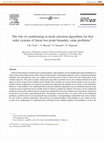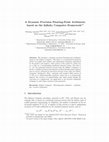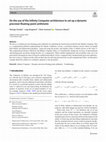Papers by Francesca Mazzia
Monthly Notices of the Royal Astronomical Society, 2019
The energy transfer among the components in a gas determines its fate. Especially at low temperat... more The energy transfer among the components in a gas determines its fate. Especially at low temperatures, inelastic collisions drive the cooling and the heating mechanisms. In the early Universe as well as in zero- or low-metallicity environments the major contribution comes from the collisions among atomic and molecular hydrogen, also in its deuterated version. This work shows some updated calculations of the H2 cooling function based on novel collisional data which explicitly take into account the reactive pathway at low temperatures. Deviations from previous calculations are discussed and a multivariate data analysis is performed to provide a fit depending on both the gas temperature and the density of the gas.
The paper presents fourth order Runge–Kutta methods derived from symmetric Hermite–Obreshkov sche... more The paper presents fourth order Runge–Kutta methods derived from symmetric Hermite–Obreshkov schemes by suitably approximating the involved higher derivatives. In particular, starting from the multi-derivative extension of the midpoint method we have obtained a new symmetric implicit Runge–Kutta method of order four, for the numerical solution of first-order differential equations. The new method is symplectic and is suitable for the solution of both initial and boundary value Hamiltonian problems. Moreover, starting from the conjugate class of multi-derivative trapezoidal schemes, we have derived a new method that is conjugate to the new symplectic method.

Codes for the numerical solution of two-point boundary value problems can now handle quite genera... more Codes for the numerical solution of two-point boundary value problems can now handle quite general problems in a fairly routine and reliable manner. When faced with particularly challenging equations, such as singular perturbation problems, the most efficient codes use a highly non-uniform grid in order to resolve the non-smooth parts of the solution trajectory. This grid is usually constructed using either a pointwise local error estimate defined at the grid points or else by using a local residual control. Similar error estimates are used to decide whether or not to accept a solution. Such an approach is very effective in general providing that the problem to be solved is well conditioned. However, if the problem is ill conditioned then such grid refinement algorithms may be inefficient because many iterations may be required to reach a suitable mesh on which to compute the solution. Even worse, for ill conditioned problems an inaccurate solution may be accepted even though the lo...

The Bari test set for IVP solvers presents a collection of Initial Value Problems to test solvers... more The Bari test set for IVP solvers presents a collection of Initial Value Problems to test solvers for implicit dierential equations. This test set can both decrease the eort for the code developer to test his software in a reliable way, and cross the bridge between the application eld and numerical mathematics, by helping people working in several branches of scientic disciplines in choosing the code most suitable for their problems. This document contains the descriptive part of the test set. It describes the solvers used in the comparisons, the test problems and their origin, and reports on the behavior of the solvers on these problems. The latest version of this document and the software part of the test set is available via the world wide web at http://www.dm.uniba.it/~testset. The software part serves as a platform on which one can test the performance of a solver on a particular test problem oneself. Instructions how to use this software are in this paper as well. The idea to ...
An appropriate mesh selection strategy is one of the fundamental tools in designing robust codes ... more An appropriate mesh selection strategy is one of the fundamental tools in designing robust codes for differential problems, especially if the codes are required to work for difficult multi scale problems. Most of the existing codes base the mesh selection on an estimate of the error (or the residual). Our strategy, based on the estimation of two parameters characterizing the conditioning of the continuous problem, as well as on an estimate of the error, not only permits us to obtain a well adapted, thus reducing the cost of the code, but also provides a measure of the conditioning of both continuous and discrete problems.

Lecture Notes in Computer Science
We introduce a dynamic precision floating-point arithmetic based on the Infinity Computer. This l... more We introduce a dynamic precision floating-point arithmetic based on the Infinity Computer. This latter is a computational platform which can handle both infinite and infinitesimal quantities epitomized by the positive and negative finite powers of the symbol x, which acts as a radix in a corresponding positional numeral system. The idea is to use the positional numeral system from the Infinity Computer to devise a variable precision representation of finite floating-point numbers and to execute arithmetical operations between them using the Infinity Computer Arithmetics. Here, numerals with negative finite powers of x will act as infinitesimal-like quantities whose aim is to dynamically improve the accuracy of representation only when needed during the execution of a computation. An application to the iterative refinement technique to solve linear systems is also presented.
The class of A-stable symmetric one-step Hermite-Obrechkoff (HO) methods introduced in [1] for de... more The class of A-stable symmetric one-step Hermite-Obrechkoff (HO) methods introduced in [1] for dealing with Initial Value Problems is analyzed. Such schemes have the peculiarity of admitting a multiple knot spline extension collocating the differential equation at the mesh points. As a new result, it is shown that these maximal order schemes are conjugate symplectic which is a benefit when the methods have to be applied to Hamiltonian problems. Furthermore a new efficient approach for the computation of the spline extension is introduced, adopting the same strategy developed in [2] for the BS linear multistep methods. The performances of the schemes are tested in particular on some Hamiltonian benchmarks and compared with those of the Gauss Runge-Kutta schemes and Euler-Maclaurin formulas of the same order.
Physics in Medicine and Biology
View the article online for updates and enhancements.
BIT Numerical Mathematics, 2016
Spline quasi-interpolation (QI) is a general and powerful approach for the construction of low co... more Spline quasi-interpolation (QI) is a general and powerful approach for the construction of low cost and accurate approximations of a given function. In order to provide an efficient adaptive approximation scheme in the bivariate setting, we consider quasi-interpolation in hierarchical spline spaces. In particular, we study and experiment the features of the hierarchical extension of the tensor-product formulation of the Hermite BS quasiinterpolation scheme. The convergence properties of this hierarchical operator, suitably defined in terms of truncated hierarchical B-spline bases, are analyzed. A selection of numerical examples is presented to compare the performances of the hierarchical and tensor-product versions of the scheme.

2015 5th International Workshop on Magnetic Particle Imaging (IWMPI), 2015
Magnetic particle imaging (MPI) is a new medical imaging technique capable of recovering the dist... more Magnetic particle imaging (MPI) is a new medical imaging technique capable of recovering the distribution of superparamagnetic particles from their measured induced signals [1]. In literature there are two main MPI reconstruction techniques: measurement-based (MB) and x-space (XS). In the first approach the unknown magnetic particles concentration is reconstructed in the harmonic-space using a System Function (SF), describing the relation between particle positions and the signal response [2, 3]. The second approach requires the knowledge of the field free point (FFP) exact position and velocity at all time steps during the scanning process [4, 5]. The x-space method is based on the assumption of ideal magnetic field shapes used for spatial encoding (selection field), and for signal excitation (focus-drive field). The realization of human size devices with an open geometry requires specific calibration procedures related to the methods used in the reconstruction phase. One of the advantages of open bore scanners would be an easier open access to the patient, especially in interventional scenarios with simultaneous and real-time scanning processes. In this case of geometry configurations with larger FOV, the exact velocity gridding for x-space MPI could be difficult to achieve during the whole scanning process. Hence, our proposal is an innovative technique named hybrid x-space (HXS) resulting from the combination of the measurement-based and the classical x-space approach, reducing and optimizing the calibration time by a compressive sensing technique using circulant matrices.

European Journal of Mechanics - B/Fluids
We open the paper with introductory considerations describing the motivations of our long-term re... more We open the paper with introductory considerations describing the motivations of our long-term research plan targeting gravitomagnetism, illustrating the fluid-dynamics numerical test case selected for that purpose, that is, a perfect-gas sphere contained in a solid shell located in empty space sufficiently away from other masses, and defining the main objective of this study: the determination of the gravitofluid-static field required as initial field (t = 0) in forthcoming fluid-dynamics calculations. The determination of the gravitofluid-static field requires the solution of the isothermalsphere Lane-Emden equation. We do not follow the habitual approach of the literature based on the prescription of the central density as boundary condition; we impose the gravitational field at the solid-shell internal wall. As the discourse develops, we point out differences and similarities between the literature's and our approach. We show that the nondimensional formulation of the problem hinges on a unique physical characteristic number that we call gravitational number because it gauges the self-gravity effects on the gas' fluid statics. We illustrate and discuss numerical results; some peculiarities, such as gravitational-number upper bound and multiple solutions, lead us to investigate the thermodynamics of the physical system, particularly entropy and energy, and preliminarily explore whether or not thermodynamic-stability reasons could provide justification for either selection or exclusion of multiple solutions. We close the paper with a summary of the present study in which we draw conclusions and describe future work.

Soft Computing
We devise a variable precision floating-point arithmetic by exploiting the framework provided by ... more We devise a variable precision floating-point arithmetic by exploiting the framework provided by the Infinity Computer. This is a computational platform implementing the Infinity Arithmetic system, a positional numeral system which can handle both infinite and infinitesimal quantities expressed using the positive and negative finite or infinite powers of the radix $${\textcircled {1}}$$ 1 . The computational features offered by the Infinity Computer allow us to dynamically change the accuracy of representation and floating-point operations during the flow of a computation. When suitably implemented, this possibility turns out to be particularly advantageous when solving ill-conditioned problems. In fact, compared with a standard multi-precision arithmetic, here the accuracy is improved only when needed, thus not affecting that much the overall computational effort. An illustrative example about the solution of a nonlinear equation is also presented.
Mathematics
Optimal control problems arise in many applications and need suitable numerical methods to obtain... more Optimal control problems arise in many applications and need suitable numerical methods to obtain a solution. The indirect methods are an interesting class of methods based on the Pontryagin’s minimum principle that generates Hamiltonian Boundary Value Problems (BVPs). In this paper, we review some general-purpose codes for the solution of BVPs and we show their efficiency in solving some challenging optimal control problems.
Numerical Algorithms
In this article, we present a new strategy to determine an unmanned aerial vehicle trajectory tha... more In this article, we present a new strategy to determine an unmanned aerial vehicle trajectory that minimizes its flight time in presence of avoidance areas and obstacles. The method combines classical results from optimal control theory, i.e. the Euler-Lagrange Theorem and the Pontryagin Minimum Principle, with a continuation technique that dynamically adapts the solution curve to the presence of obstacles. We initially consider the two-dimensional path planning problem and then move to the three-dimensional one, and include numerical illustrations for both cases to show the efficiency of our approach.

Journal of Intelligent Information Systems
Saliency detection mimics the natural visual attention mechanism that identifies an imagery regio... more Saliency detection mimics the natural visual attention mechanism that identifies an imagery region to be salient when it attracts visual attention more than the background. This image analysis task covers many important applications in several fields such as military science, ocean research, resources exploration, disaster and land-use monitoring tasks. Despite hundreds of models have been proposed for saliency detection in colour images, there is still a large room for improving saliency detection performances in hyperspectral imaging analysis. In the present study, an ensemble learning methodology for saliency detection in hyperspectral imagery datasets is presented. It enhances saliency assignments yielded through a robust colour-based technique with new saliency information extracted by taking advantage of the abundance of spectral information on multiple hyperspectral images. The experiments performed with the proposed methodology provide encouraging results, also compared to s...

Opuscula Mathematica
In this work we propose a novel application of Partial Differential Equations (PDEs) inpainting t... more In this work we propose a novel application of Partial Differential Equations (PDEs) inpainting techniques to two medical contexts. The first one concerning recovering of concentration maps for superparamagnetic nanoparticles, used as tracers in the framework of Magnetic Particle Imaging. The analysis is carried out by two set of simulations, with and without adding a source of noise, to show that the inpainted images preserve the main properties of the original ones. The second medical application is related to recovering data of corneal elevation maps in ophthalmology. A new procedure consisting in applying the PDEs inpainting techniques to the radial curvature image is proposed. The images of the anterior corneal surface are properly recovered to obtain an approximation error of the required precision. We compare inpainting methods based on second, third and fourth-order PDEs with standard approximation and interpolation techniques.

Uploads
Papers by Francesca Mazzia